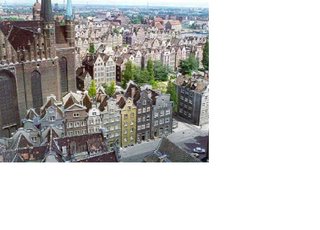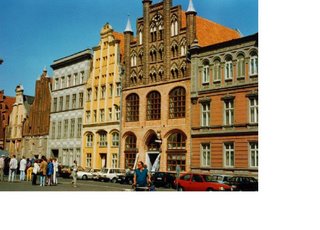




In response to Jeff Hudelson's request (and who among us can refuse the Duke of Saxe-Bearstein himself?) , here are a few examples of what I termed the "Hansa Style" in my Saturday post -- A style of architecture left to us by the North German (and Flemish) merchants who were active all over Northern Europe for several centuries from about the mid-1100s to the mid-1700s (this is very approximate).
I'll use these structures as models (is that a pun?) for the 6-10 miniature buildings I'll make to go along with my imaginary mid-18th Century armies. I plan to create things like a church, a town hall, several houses with "gabled" end walls, a warehouse, a tavern, and maybe a farmhouse plus barn or two. All structures will be slightly scaled down, so that they don't take up inordinate amounts of table space, but I'll lavish enough construction attention and painting detail on them, so that they are not simply symbolic pieces like those seen in the Grants' books and articles.
To the contrary, I am an Ian Weekley disciple! Ok. . . Maybe not terribly "old school" in outlook and design, but I like interesting buildings and scenery to go with my military figures. Anyway, these photos are of existing buildings in (from the top) Tallin, Estonia -- Riga, Latvia -- Gdansk, Poland -- Stralsund, Germany -- and Bremen, Germany. Enjoy!
Comments
The photos are wonderful. I particularly like the first one with the marvelous range of palette colours . . . I hope that your buildings will have a range of colours (I've always liked that).
I will confess that this style is not my favorite -- but you're not building them for me, are you?
They do have small "footprints" for their height and should be relatively easy to build.
Just in case you haven't ever used "foam core", take a look at this website:
http://www.zeitcom.com/majgen/39howst.html
The concept makes good, strong, lightweight buildings. Of course you would have to adjust the style, but the concepts are good.
-- Jeff
http://saxe-bearstein.blogspot.com/
I'd also like to find some good examples from southern Germany in and around the area where the battle of Blenheim (Blindheim or 2nd Höchstedt) was fought.
I'm also thinking about using foamboard as a base but I'll be making stuff that will work with 10mm figures. I'll do details like half-timbers, doors, windows, etc. with card, balsa and/or bass wood and whatever else looks like it will work.
Looking forward to seeing how your stuff turns out!
I too have some 15mm buildings that match the style.
I have started a church in 25mm, to keep up with some 25mm barns and early industrial buildings that I got off eBay. They are ok but the basic wooden structures are, bland.
I made the church out of a powder putty material using rubber moulds by LINKA. They are meant for railway buildings but they have some castle pieces that can easily do the conversion into the style you are working on.
Two links:
What is LINKA?
and
LinkaWorld
The Bavarian city scene may be of interest.
Cheers